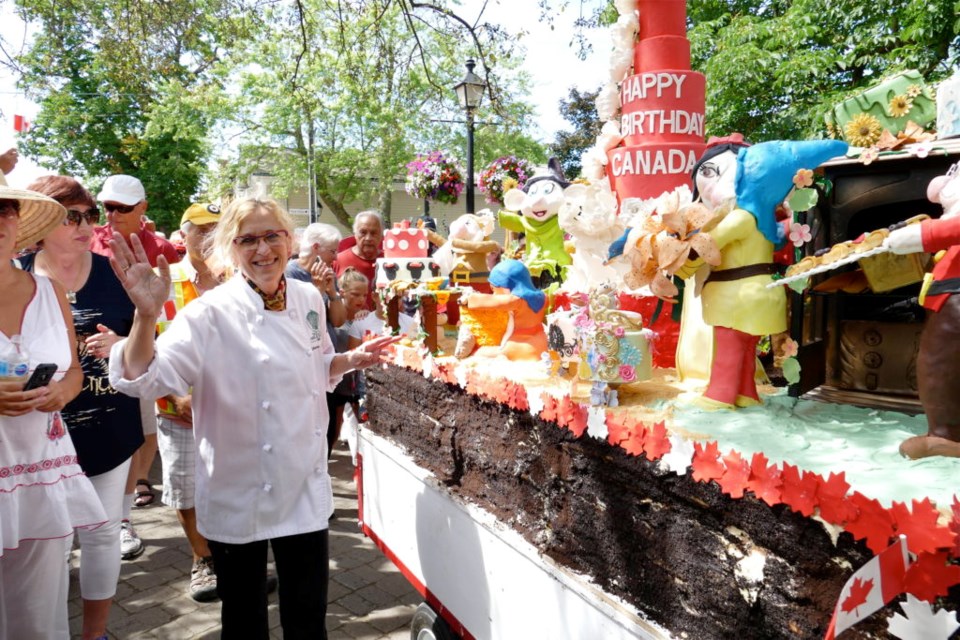
Catherine O’Donnell typically begins working on the cake of all cakes — the one that ranks its own parade, accompanied by a fife and drum corps — in January.
This year the process has been a little rushed — the decision that there would be Canada Day celebrations in Niagara-on-the-Lake hadn’t been made in January.
However, the Willow Cakes and Pastries chef, creator of the gigantic cake that has been a centrepiece of Canada Day celebrations for many years, and paraded along Queen Street to Simcoe Park, didn’t have to start from scratch.
When COVID hit in March of 2020, she had a design ready to implement and was already putting together some of the “many little elements” that would be incorporated. Those figures we see on the tops of her cakes are made to be edible, she explains, although they’re not actually eaten, so those that were made in 2020 can still be used. She is going with the 2020 design for the cake that was never made, but is adapting it with some “whimsical” touches to reflect “the new world” that has evolved over the last two years, she says.
O’Donnell always keeps her designs a secret, to be a surprise once the cake walk begins on Canada Day, so she’s not saying too much about it. She did tell The Local one of the figures on the top of the cake is almost five feet tall, and can’t fit in the bakery — she will have a tent up outside on the eve of Canada Day, placing it on the cake at the last minute.
Although she won’t say more about the design, she does talk about how the pandemic changed her world, and so many others in NOTL.
“I’m so grateful the community has stood behind local businesses,” she says. “To still have my doors open, to still be able to make this cake for the community — for that I’m so thankful.”
She never had to close her doors, she said, but there were restrictions that were costly, such as the plexiglass that was added for safety. She closed two days a week to give her staff a break and keep them safe, she’s been doing more deliveries, and had to pack products differently. While it’s been costly to adapt, “we live in the best town in the world,” she says. “People just kept ordering.”
O’Donnell recently returned from a trip to Saskatchewan, where she was inducted into the Canadian Culinary Federation’s honour society, which promotes “culinary excellence, friendship and good will.” It was developed to honour and recognize leadership, professional excellence, lifetime commitment and significant contributions to the profession, O’Donnell’s certificate says.
And amongst the 200 chefs who were at the conference, there was one ongoing “big conversation,” and that was about staffing problems. It’s hard to get staff, they agreed, it’s hard to keep them, and they are stressed. Although most customers are “beyond great,” O’Donnell says, there are also customers who are rude — themselves possibly stressed as a result of the pandemic — and when they take it out on the young person behind the counter, it doesn’t end well, often resulting in tears and meltdowns.
“There are customers who just don’t know how to be kind anymore,” she says.
Stressed-out staff want to put in their hours and go home — they don’t want to volunteer for helping with the Canada Day Cake, O’Donnell adds.
“Young people have had a really difficult time during the pandemic. It’s really stressed them, and it’s changed their lives.”
COVID, she says, “has made running a business in town much harder. It’s everywhere. But we’re lucky to be in business.”
So part of her message as she reflects on this year’s cake is about being kinder, more compassionate, and more understanding of others.
O’Donnell was at an event at St. Mark’s Church to honour Donald Combe last Sunday, a long-time friend of hers. She donated the dessert for the evening, and says how good it felt to be part of something so positive, that was all about community, and saying thank you.
“We all have to step back and ask, how can we be kind, how can we be helpful?”
And, she adds, “we have to say thank you to everyone who has kept our doors open, and 16 staff working. That’s a big reason for doing this cake.”
In the past, O’Donnell has tried to find donations of ingredients from suppliers — it takes a lot of flour and fondant to make an elaborate eight-foot by five-foot cake —and has also sought cash donations to offset the cost. This year, she’s decided not to do that.
“How do we go out to other businesses and ask for help? We’re all in this together, and I don’t feel we can ask for money.”
She’s a little concerned about people feeling uncomfortable, being “squished” during the crush at Simcoe Park when people are waiting for their slice of cake — there is always a big crowd gathered around it — and says there will be people likely wearing masks, even though they’re outside.
She is encouraging people to step back, leave some space around them, and think about “respect and kindness, and how can we show it to each other.”
The cake walk down Queen Street begins at 2:45 p.m. July 1, making its way slowing through the crowd at Simcoe Park, led by the 41st Regiment of Foot Fife and Drum Corps accompanying a giant cake, concluding in the park with the slicing, usually beginning around 3:30 p.m.